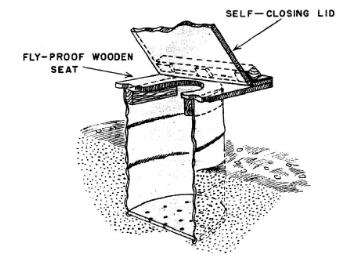UNITED STATES MARINE CORPS
Field Medical Training Battalion
Camp Lejeune
FMST
1603
Supervise Field Waste Disposal
TERMINAL LEARNING OBJECTIVES
1.
Given the
requirement in a tactical environment, necessary equipment and supplies, and the
references, supervise field waste disposal, to reduce the incidence of disease
per the reference. (FMST-FP-1603)
ENABLING LEARNING OBJECTIVES
1.
Without the aid of
references, given a description or title, identify the types of field waste, per
the student handout. (FMST-FP-1603a)
2. Without the aid of
references, given a description or list, identify the preferred method of
disposal for each type of field waste, per the student handout. (FMST-FP-1603b)
3. Without the aid of
references, given a list, identify the uses of field sanitation devices per
number of personnel, per the student handout. (FMST-FP-1603c)
1.
OVERVIEW
Historically, in every conflict the US has been involved in, only
20% of all hospital admissions have been from combat injuries. The other 80% have
been from diseases not related to battle, commonly referred to as Disease Non
Battle Injury (DNBI). Excluded from these figures are vast numbers of service
members with decreased combat effectiveness due to DNBI not serious enough for
hospital admission.
Preventive medicine measures are simple, common
sense actions that any service member can perform and every leader must know.
The application of preventive medicine measures can significantly reduce time
lost due to DNBI. The intent of this lesson is not to make you preventive
medicine experts. You will have access to them through the Environmental
Preventive Medicine Units (EPMU) that deploy in times of war or conflict. This
course is to give you knowledge of the basic skills necessary to employ safe
preventive medicine practices for your Marines.
2.
WASTE
Definition - all types of liquid and
solid material excreted from the body as useless or unnecessary as a result of
living activities of humans or animals.
Types of
Waste
Human waste (black water): Liquid
waste containing human urine and fecal matter.
Liquid Waste (Gray Water): Liquid
waste containing water used for bathing or liquid waste from kitchen operation.
Garbage: Any kind of non-liquid organic
materials resulting from food service operations.
Rubbish: Waste consisting of
non-organic materials such as boxes, cans, paper, or plastics.
2.
GUIDELINES FOR LATRINE PLACEMENT
When determining the location for latrines, give consideration to
protecting food and water supplies from contamination as well as providing
convenient accessibility. Place as far from food operations as possible (328
feet or more). Other considerations include:
- Downwind and down slope, if possible.
- Down slope from wells, springs, streams, and other water
sources (100 feet or more).
- At least 50 feet from berthing areas.
|

Burn Barrel Latrine |
3. FIELD SANITATION DEVICES USED FOR FECAL
DISPOSAL
The type of improvised waste disposal used will depend on the
mission, length of stay in the area, terrain, and weather conditions. The
primary means of human waste disposal in a bivouac area is a chemical toilet. When chemical toilets are not available, the burn-out latrine
is the preferred improvised waste disposal device.
Chemical Toilets
- Latrines maintained by
contracted services.
-
One toilet can service up to 15 personnel.
Burn
Barrel Latrine - the burn-barrel is a
commonly used device for human waste disposal in the field. Best employed in
areas where the water table is high or the ground does not permit digging.
Personnel utilizing the Burn Barrel Latrine are encouraged to use urinals for
urination instead of the Burn Barrel Latrine since additional fuel is needed to
burn urine and feces.
Cat
Hole - used for the disposal of individual human
excrement in situations where other latrines are not available such as when on
the march and at short halts.
- One
foot wide by one foot deep.
- Covered immediately after use to prevent flies from spreading
germs from waste to your food.
4.
FIELD SANITATION DEVICES USED FOR LIQUID WASTE
DISPOSAL
Liquid waste disposal methods are primarily designed to maximize
the evaporation of the waste. Using items such as rocks increases the surface
area and allows the waste to dissipate quickly. Liquid kitchen or bathing waste
disposal methods include:
- Soakage pits.
- Evaporation beds.
5.
FIELD SANITATION DEVICES FOR GARBAGE AND RUBBISH
DISPOSAL
Every individual generates some type of garbage. The bigger
the unit, the bigger the problem! It is important that you are able to
make appropriate recommendations to the unit commander regarding the disposal of
solid waste. The preferred method of garbage disposal for short overnight
stops is the garbage pit. A standard four feet by four feet pit will
service 100 people per day. For longer stays, a garbage trench is used.
The trench measures two feet wide by four feet deep and is extended as needed.
6.
GUIDELINES FOR GARBAGE PIT DISPOSAL DEVICE
PLACEMENT
- Recommend at least 100 feet
from mess area
- Recommend at least 100 feet
from water source
- Incinerators must also be at
least 150 feet downwind from camp
REFERENCES
Naval
Preventive Medicine Manual, NAVMED P-5010, Pgs 9-17 through 9-30
Field
Hygiene and Sanitation, FM 21-10, June 2000
REV: July 2008
Field Waste Review
1. Describe garbage.
2. What is the preferred method of fecal disposal when chemical toilets are not
available?
3.
Describe a “cat
hole”
4. What is the preferred method of garbage disposal for a unit making an
overnight halt?
|

